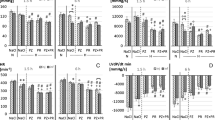Abstract
Studies were conducted on 29 male healthy subjects having no previous experience of living at high altitude. These subjects were divided into three groups, i.e., subjects treated with placebo, acetazolamide and spironolactone. These subjects were first studied in Delhi. The drug schedule was started 24 hour prior to the airlift of these subjects to an altitude of 3,500 m and was continued for 48 hour after arrival at high altitude. Total body water, extra cellular water, plasma volume, blood electrolytes, pH, pO2, pCO2 and blood viscosity were determined on 3rd and 12th day of their stay at high altitude. Total body water, extra cellular water intracellular water and plasma volume decreased on high altitude exposure. There was a further slight decrease in these compartments with acetazolamide and spironolactone. It was also observed that spironolactone drives out more water from the extracellular compartment. Loss of plasma water was also confirmed by increased plasma osmolality. Increase in arterial blood pH was noticed on hypoxic exposure but the increase was found less in acetazolamide and spironolactone cases. This decrease in pH is expected to result in better oxygen delivery to the tissues at the low oxygen tension. It was also confirmed because blood pO2 increased in both the groups. No significant change in plasma electrolytes was observed in subjects of various groups. Blood viscosity slightly increased on exposure to high altitude. The degree of rise was found less in the group treated with spironolactone. This study suggests that both the drugs are likely to be beneficial in ameliorating/prevention of AMS syndrome.
Similar content being viewed by others
References
AOKI, V. S. and ROBINSON, S. M. (1971): Body hydration and the incidence and severity of acute mountain sickness. J. Appl. Physiol., 31: 363–367.
BAUAR, F. K. (1971): Radiosotope dilution methods: Measurement of body composition. In: Nuclear Medicine. W. H. Blahd (Ed) McGraw Hill Inc., New York, pp. 574–592.
CAIN, S. M. and DUNN, J. E. (1966): Low doses of acetazolamide to aid accomodation of men to altitude. J. Appl. Physiol. 21: 1195–1200.
CARSON, R. P., EVANS, W. O., SHIELDS, J. L. and HANNON, J. P. (1969): Symptomatology, pathophysiology and treatment of acute mountain sickness. Fed. Proc. 28: 1085–1091.
CONSOLAZIO, C. F., MATOUSH, L. O., JOHNSON, H. L. and DAWS, T. A. (1968): Proteins and water balances of young adults during prolonged exposure to high altitude (4300 m) Am. J. Clin. Nutr. 21: 154–161.
CURIE, T. T., CARTER, H. P., CHAMPION, W. L., FENG, G., FRANCIS, K. J., McDONALD, I. N., NEWING, K., NUNN, I. N., SISSION, N. P., SUSSEX, M. and ZACHARIAN, F. P. (1976): Spironolactone and acute mountain sickness. Med. J. Aust. 2, 168.
EVANS, W. O., ROBINSON, S. M., HORSTMAN, D. H., JACKSON, R. E. and WEISKOPF, R. B. (1976): Amelioration of the symptoms of acute mountain sickness by staging and acatazolamide. Aviat. Space Environ. Med. 47: 512–516.
FORWARD, S. A., LANDOWNE, M., FOLLENSBAC, J. N. and HANSEN, J. E. (1968): Effect of acetazolamide on acute mountain sickness. New. Engl. J. Med. 279: 839–845.
GRAY, G. W., BRYAN, A. C., FRAYSER, R., HOUSTON, C. S. and RENNIE, I. D. B. (1971): Control of acute mountain sickness. Aerospace. Med. 42: 81–84.
HOBBS, J. H. (1968): Total blood volume: Its measurement and significance. Med. Monograph No. 3. The Radiochemical Centre, Amersham.
LAUX, B. E. and RAICHLE, N. E. (1978): The effects of acetazolamide and cerebral blood flow and oxygen utilization in the Rhesus monkey. J. Clin. Invest. 62: 585–592.
PICON-REATEGUI, E. (1961): Basal metabolic rate and body composition at high altitudes. J. Appl. Physiol. 16: 431–434.
PUGH, L. G. G. F. (1964): Blood volume and haemoglobin concentration at altitude above 18,000 ft (5,500 m). J. Physiol. (London) 170: 344–354.
RAND, W. P., LACOMBE, E., HAMILTON, E. H. and AUSTIN, H. A. (1964): Viscosity of normal human blood under normotheric and hypothermic conditions. J. Appl. Physiol. 19: 117–122.
RICHARD, L. B., LANDOWNE, M., ANDREW, J. Y. and JOHN, T. M. (1982): Phenytoin: Ineffective against acute mountain sickness. Aviat. Space Environ. Med. 53: 221–225.
SURKS, M. I., CHINN, S. K. and MATHOUSH, I. O. (1966): Alterations in body composition in man after acute exposure to high altitude. J. Appl. Physiol. 21: 1741–1746.
WALSER, M., SELDIN, D. W. and GROLLMAN, A. (1953): An evaluation of radiosulphate for determination of the volume of extracellular fluid in man and dogs. J. Clin. Invest. 32: 299–311.
WATERLOW, J. C. and BUNJE, H. W. (1966): Observation on mountain sickness in the Colombianandes, Lancet, 2: 655–661.
Author information
Authors and Affiliations
Rights and permissions
About this article
Cite this article
Singh, M.V., Jain, S.C., Rawal, S.B. et al. Comparative study of acetazolamide and spironolactone on body fluid compartments on induction to high altitude. Int J Biometeorol 30, 33–41 (1986). https://doi.org/10.1007/BF02192056
Received:
Issue Date:
DOI: https://doi.org/10.1007/BF02192056




